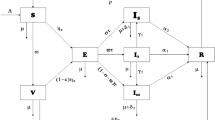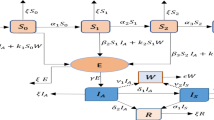Abstract
The highly infectious and low-mortality Omicron variant of COVID-19 was identified in Botswana and reported to the WHO by South Africa. Spread dynamics is often used in the study of infectious diseases. Seasons, human contact, vaccination and other factors are the important factors affecting the spread of diseases. To better study the dynamical characteristics and predict the epidemic trend of the Omicron variants, we propose modified infectious disease models based on the SEIAR model, and examine the spread of the Omicron variants using mathematical modeling. We modify the traditional SEIAR model with incorporating a new factor: the number of vaccinations. The first modified model is referred to as the \(\hbox {SUV}_\textrm{1st}\hbox {V}_\textrm{2nd}\)IARD model, which is applicable to the period before the outbreak of Omicron. Given the high infectivity of the Omicron variants and the role of vaccinations in reducing the spread risk during the outbreak of Omicron, we further add a factor for vaccination booster and construct a new dynamical model different from \(\hbox {SUV}_\textrm{1st}\hbox {V}_\textrm{2nd}\)IARD model, called the \(\hbox {SV}_\textrm{2nd}\hbox {V}_\textrm{3rd}\)IARD model. Through stability analysis, we confirm the existence of the local asymptotic stability of the disease-free equilibrium point and the local equilibrium point under the given conditions for both \(\hbox {SUV}_\textrm{1st}\hbox {V}_\textrm{2nd}\)IARD model and \(\hbox {SV}_\textrm{2nd}\hbox {V}_\textrm{3rd}\)IARD model. Additionally, sensitivity analysis is performed on the basic regeneration number of both models. Parameter estimation and numerical simulations are conducted using the epidemic data from Tokyo, Japan. Through sensitivity analysis, we find that increasing vaccination rates and reducing human contact can reduce the number of infections and alleviate medical pressure. To prevent and control the epidemic, the government can minimize human contact and promote the necessity of vaccination to the public, as they can effectively improve individual immunity, reduce the risk of virus infection, and limit the virus spread.















Similar content being viewed by others
Data availability
All data generated or analyzed during this study are included in this published article.
References
WHO statement on novel coronavirus in Thailand. https://www.who.int/news/item/13-01-2020-who-statement-on-novel-coronavirus-in-Thailand
WHO Director-General’s opening remarks at the Special Session of the World Health Assembly. https://www.who.int/director-general/speeches/detail/who-director-general-s-opening-remarks-at-the-special-session-of-the-world-health-assembly---29-november-2021
Omicron Comes to China, Prompting Mass Testing and Quarantines. https://www.wsj.com/articles/omicron-comes-to-china-prompting-mass-testing-and-quarantines-11641736166?reflink=desktopwebshare_permalink
The first discovery of variant strain XBB of Omikjon subtype in Tokyo, Japan. http://news.hnr.cn/shxw/article/1/1585624641482739714
Ben Hassen, H., Elaoud, A., Ben Salah, N., Masmoudi, A.: A sir-poisson model for COVID-19: evolution and transmission inference in the Maghreb central regions. Arab. J. Sci. Eng. 46(1), 93–102 (2021). https://doi.org/10.1007/s13369-020-04792-0
Ferreyra, E.J., Jonckheere, M., Pinasco, J.P.: Sir dynamics with vaccination in a large configuration model. Appl. Math. Optim. 84(2), 1769–1818 (2021). https://doi.org/10.1007/s00245-021-09810-7
Lounis, M., Bagal, D.K.: Estimation of sir model’s parameters of COVID-19 in Algeria. Bull. Natl. Res. Centre 44(1), 180 (2020). https://doi.org/10.1186/s42269-020-00434-5
Meng, X., Li, Z., Wang, X.: Dynamics of a novel nonlinear sir model with double epidemic hypothesis and impulsive effects. Nonlinear Dyn. 59(3), 503–513 (2010). https://doi.org/10.1007/s11071-009-9557-1
Saxena, R., Jadeja, M., Bhateja, V.: Propagation analysis of COVID-19: an sir model-based investigation of the pandemic. Arab. J. Sci. Eng. (2021). https://doi.org/10.1007/s13369-021-05904-0
Vinitsky, S.I., Gusev, A.A., Derbov, V.L., Krassovitskiy, P.M., Pen’kov, F.M., Chuluunbaatar, G.: Reduced sir model of COVID-19 pandemic. Comput. Math. Math. Phys. 61(3), 376–387 (2021). https://doi.org/10.1134/S0965542521030155
Lü, X., Hui, H.-w, Liu, F.-f, Bai, Y.-l: Stability and optimal control strategies for a novel epidemic model of COVID-19. Nonlinear Dyn. 106(2), 1491–1507 (2021). https://doi.org/10.1007/s11071-021-06524-x
Jia, L., Chen, W.: Uncertain SEIAR model for COVID-19 cases in china. Fuzzy Optim. Decis. Making 20(2), 243–259 (2021). https://doi.org/10.1007/s10700-020-09341-w
Lehnig, C.L., Oren, E., Vaidya, N.K.: Effectiveness of alternative semester break schedules on reducing COVID-19 incidence on college campuses. Sci. Rep. 12(1), 2116 (2022). https://doi.org/10.1038/s41598-022-06260-1
Biswas, S.K., Ghosh, J.K., Sarkar, S., Ghosh, U.: COVID-19 pandemic in India: a mathematical model study. Nonlinear Dyn. 102(1), 537–553 (2020). https://doi.org/10.1007/s11071-020-05958-z
Das, P., Nadim, S.S., Das, S., Das, P.: Dynamics of COVID-19 transmission with comorbidity: a data driven modelling based approach. Nonlinear Dyn. 106(2), 1197–1211 (2021). https://doi.org/10.1007/s11071-021-06324-3
Jia, Q., Li, J., Lin, H., Tian, F., Zhu, G.: The spatiotemporal transmission dynamics of COVID-19 among multiple regions: a modeling study in Chinese provinces. Nonlinear Dyn. 107(1), 1313–1327 (2022). https://doi.org/10.1007/s11071-021-07001-1
Kyrychko, Y.N., Blyuss, K.B., Brovchenko, I.: Mathematical modelling of the dynamics and containment of COVID-19 in Ukraine. Sci. Rep. 10(1), 19662 (2020). https://doi.org/10.1038/s41598-020-76710-1
Yin, M. Z., Zhu, Q. W., Lü, X.: Parameter estimation of the incubation period of COVID-19 based on the doubly interval-censored data model, Nonlinear Dyn. 106, 1347 (2021). https://doi.org/10.1007/s11071-021-06587-w
Ma, Z., Wang, S., Lin, X., Li, X., Han, X., Wang, H., Liu, H.: Modeling for COVID-19 with the contacting distance. Nonlinear Dyn. 107(3), 3065–3084 (2022). https://doi.org/10.1007/s11071-021-07107-6
Péni, T., Csutak, B., Szederkényi, G., Röst, G.: Nonlinear model predictive control with logic constraints for COVID-19 management. Nonlinear Dyn. 102(4), 1965–1986 (2020). https://doi.org/10.1007/s11071-020-05980-1
Saha, P., Biswas, S.K., Biswas, M.H.A., Ghosh, U.: An SEQAIHR model to study COVID-19 transmission and optimal control strategies in Hong Kong, 2022. Nonlinear Dyn. (2023). https://doi.org/10.1007/s11071-022-08181-0
Saikia, D., Bora, K., Bora, M.P.: COVID-19 outbreak in India: an SEIR model-based analysis. Nonlinear Dyn. 104(4), 4727–4751 (2021). https://doi.org/10.1007/s11071-021-06536-7
Zlatić, V., Barjašić, I., Kadović, A., Štefančić, H., Gabrielli, A.: Bi-stability of SUDR+K model of epidemics and test kits applied to COVID-19. Nonlinear Dyn. 101(3), 1635–1642 (2020). https://doi.org/10.1007/s11071-020-05888-w
Kumari, P., Singh, H.P., Singh, S.: SEIAQRDT model for the spread of novel coronavirus (COVID-19): a case study in India. Appl. Intell. 51(5), 2818–2837 (2021). https://doi.org/10.1007/s10489-020-01929-4
Zhao, Q., Wang, Y., Yang, M., Li, M., Zhao, Z., Lu, X., Shen, B., Luan, B., Zhao, Y., Cao, B., Yao, L., Zhao, B., Su, Y., Chen, T.: Evaluating the effectiveness of measures to control the novel coronavirus disease 2019 in Jilin province, China. BMC Infect. Dis. 21(1), 245 (2021). https://doi.org/10.1186/s12879-021-05936-9
Zhao, Z.-Y., Chen, Q., Zhao, B., Hannah, M.N., Wang, N., Wang, Y.-X., Xuan, X.-F., Rui, J., Chu, M.-J., Yu, S.-S., Wang, Y., Liu, X.-C., An, R., Pan, L.-L., Chiang, Y.-C., Su, Y.-H., Zhao, B.-H., Chen, T.-M.: Relative transmissibility of shigellosis among male and female individuals: a modeling study in Hubei province, China. Infect. Dis. Poverty 9(1), 39 (2020). https://doi.org/10.1186/s40249-020-00654-x
Jiang, H., Song, P., Wang, S., Yin, S., Yin, J., Zhu, C., Cai, C., Xu, W., Li, W.: Quantitative assessment of the effectiveness of joint measures led by Fangfang shelter hospitals in response to COVID-19 epidemic in Wuhan, China. BMC Infect. Dis. 21(1), 626 (2021). https://doi.org/10.1186/s12879-021-06165-w
Suryawanshi, R.K., Chen, I.P., Ma, T., Syed, A.M., Brazer, N., Saldhi, P., Simoneau, C.R., Ciling, A., Khalid, M.M., Sreekumar, B., Chen, P.-Y., Kumar, G.R., Montano, M., Gascon, R., Tsou, C.-L., Garcia-Knight, M.A., Sotomayor-Gonzalez, A., Servellita, V., Gliwa, A., Nguyen, J., Silva, I., Milbes, B., Kojima, N., Hess, V., Shacreaw, M., Lopez, L., Brobeck, M., Turner, F., Soveg, F.W., George, A.F., Fang, X., Maishan, M., Matthay, M., Morris, M.K., Wadford, D., Hanson, C., Greene, W.C., Andino, R., Spraggon, L., Roan, N.R., Chiu, C.Y., Doudna, J.A., Ott, M.: Limited cross-variant immunity from SARS-COV-2 omicron without vaccination. Nature 607(7918), 351–355 (2022). https://doi.org/10.1038/s41586-022-04865-0
Jin, Z., Zhang, J., Song, L.P., Sun, G.Q., Kan, J., Zhu, H.: Modelling and analysis of influenza a (h1n1) on networks. BMC Public Health 11, 9 (2011). https://doi.org/10.1186/1471-2458-11-s1-s9
Kasereka, S.K., Zohinga, G.N., Kiketa, V.M., Ngoie, R.-B.M., Mputu, E.K., Kasoro, N.M., Kyandoghere, K.: Equation-based modeling vs. agent-based modeling with applications to the spread of COVID-19 outbreak. Mathematics 11(1), 253 (2023)
Bacaër, N.: Approximation of the basic reproduction number r0 for vector-borne diseases with a periodic vector population. Bull. Math. Biol. 69(3), 1067–1091 (2007). https://doi.org/10.1007/s11538-006-9166-9
Yang, C., Wang, J.: Basic reproduction numbers for a class of reaction-diffusion epidemic models. Bull. Math. Biol. 82(8), 111 (2020). https://doi.org/10.1007/s11538-020-00788-x
Guan, G., Guo, Z.: Stability behavior of a two-susceptibility shir epidemic model with time delay in complex networks. Nonlinear Dyn. 106(1), 1083–1110 (2021). https://doi.org/10.1007/s11071-021-06804-6
Shakya, R.K., Ayane, T.H., Diba, F.D., Mamoria, P.: SEIRS model with spatial correlation for analyzing dynamic of virus spreading in event-driven wireless sensor networks. Int. J. Syst. Assur. Eng. Manag. 13(2), 752–760 (2022). https://doi.org/10.1007/s13198-021-01336-z
Saha, P., Ghosh, U.: Global dynamics and control strategies of an epidemic model having logistic growth, non-monotone incidence with the impact of limited hospital beds. Nonlinear Dyn. 105(1), 971–996 (2021). https://doi.org/10.1007/s11071-021-06607-9
Chen, X., Cao, J., Park, J.H., Qiu, J.: Stability analysis and estimation of domain of attraction for the endemic equilibrium of an SEIQ epidemic model. Nonlinear Dyn. 87(2), 975–985 (2016). https://doi.org/10.1007/s11071-016-3092-7
Updates on COVID-19 in Tokyo. https://stopcovid19.metro.tokyo.lg.jp/zh-cn/
Acknowledgements
The authors would like to express their thanks to the unknown referees for their careful reading and helpful comments. This work is supported by the Beijing Natural Science Foundation (7232101), by the Research Foundation of Ministry of Education of China (8091B022138), and by the Beijing Laboratory of National Economic Security Early-warning Engineering, Beijing Jiaotong University. Feng Cao and Yi-Xuan Zhou are supported by the Project of National Training Program of Innovation and Entrepreneurship for Undergraduates under Grant No. 202310004014.
Author information
Authors and Affiliations
Corresponding authors
Ethics declarations
Conflict of interest
The authors declare that they have no conflict of interest concerning the publication of this manuscript.
Additional information
Publisher's Note
Springer Nature remains neutral with regard to jurisdictional claims in published maps and institutional affiliations.
Rights and permissions
Springer Nature or its licensor (e.g. a society or other partner) holds exclusive rights to this article under a publishing agreement with the author(s) or other rightsholder(s); author self-archiving of the accepted manuscript version of this article is solely governed by the terms of such publishing agreement and applicable law.
About this article
Cite this article
Cao, F., Lü, X., Zhou, YX. et al. Modified SEIAR infectious disease model for Omicron variants spread dynamics. Nonlinear Dyn 111, 14597–14620 (2023). https://doi.org/10.1007/s11071-023-08595-4
Received:
Accepted:
Published:
Issue Date:
DOI: https://doi.org/10.1007/s11071-023-08595-4




